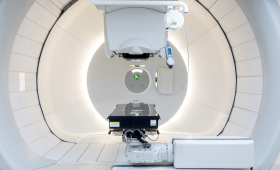Linear accelerator
1、What is a linear accelerator
Linear accelerators are devices that accelerate electrons, protons and heavy ions using a high-frequency electric field distributed along a straight track. Usually, high power high frequency or microwave power source is used to excite the accelerator cavity. The acceleration field of linear accelerator has two types: traveling wave and standing wave. Since electrons approach the speed of light even at low energies, most electron linAC accelerators use traveling wave acceleration.
2. Advantages of linear accelerator radiotherapy
Fast: The treatment time is short, it only takes about 3 minutes to complete the treatment.
Accuracy: CBCT (conical beam CT) can be verified before treatment, ensure the accuracy of treatment, and effectively improve the accuracy of radiation therapy. The Symmetry4D function can track the tumor in real time, analyze and compare the movement of the target area in each respiratory cycle, and calculate the true movement trajectory of the tumor on the internal organs and the scope of treatment required, perfectly solving the treatment bottleneck of the moving target area.
Fine: Ensure that the ray can sculptively hit the tumor tissue, while protecting the surrounding normal tissue, so that the surrounding normal tissue damage to the minimum. Frame rotation Angle accuracy is controlled at 0.1 degree; The error accuracy of the XVI robot arm is +/-1mm; The width of multi-leaf grating is 5mm, and the accuracy in place is 0.5mm; The accuracy of the six-dimensional bed: the translation accuracy is submillimeter; Rotation Angle accuracy +/-0.3 degrees.
Axesse high energy linear accelerator represents the world's most advanced technology of tumor radiation therapy equipment, powerful, wide range of application, the treatment of various malignant tumors and some benign lesions excellent effect, good efficacy, few side effects, some diseases can achieve painless, non-invasive, no obvious side effects of surgical resection effect. This is a revolutionary change in the field of cancer treatment and will actually bring benefits to patients.
3、Indications of linear accelerator radiotherapy
Linear accelerators have a wide range of indications, and can be used for primary or secondary tumors in the head and neck, thoracic cavity, abdominal cavity, pelvic cavity, limbs and other parts, as well as residual postoperative or preoperative treatment before surgery. Indications for conventional radiotherapy are:
1. Simple treatment of tumors: nasopharyngeal cancer, early laryngeal cancer, early oral cancer, paranasal sinus cancer, early malignant lymphoma, medulloblastoma, basal cell carcinoma, lung cancer, seminoma, esophageal cancer, etc.
2. Combined with chemotherapy to treat tumors: small cell lung cancer, middle and advanced malignant lymphoma, etc.
3. Combined treatment with surgery: maxillary sinus, ENT cancer, glioma, lung cancer, thymoma, gastrointestinal cancer, soft tissue sarcoma, etc. Planned preoperative radiotherapy, intraoperative radiotherapy and postoperative radiotherapy.
4. Palliative radiotherapy: analgesic radiotherapy for bone metastases, radiotherapy for brain metastases, palliative therapy for advanced tumors.
When it is used in three-dimensional conformal radiotherapy (3D-CRT) and intensity modulated radiotherapy (IMRT), its indications are:
Intracranial tumors: especially those located in important anatomical structures with irregular morphology that are not suitable for surgery or difficult to remove.
2. Head and neck tumors: including residual or recurrent tumors after surgery or conventional radiotherapy, such as nasopharyngeal carcinoma and skull base tumor.
3. Spinal (pulp) tumors
4. Chest tumor: such as mediastinal tumor, lung cancer, chest wall tumor
5. Digestive, urinary, reproductive system tumors: such as liver cancer, pancreatic cancer, prostate cancer.
6. Metastatic cancer in all parts of the body.
Related videos
-
 Can Traditional Chinese Medicine Treat Lung Cancer: Saving or Killing Lives
Can Traditional Chinese Medicine Treat Lung Cancer: Saving or Killing Lives一洲在线
-
 Many of these four types of cancer can survive for a long time
Many of these four types of cancer can survive for a long time健康在线
Recommended Reading
-

Great Lecture Hall | Development and Trends in Cancer Therapy
2023-09-01 08:14:00 -

Happy birthday in the ward, let the children smile more brightly
2023-08-29 14:10:55 -

Post flood reconstruction in Zhuozhou, Yizhou Cancer Hospital in action
2023-08-29 11:59:27 -
Our hospital has organized post disaster free clinics in communities such as Shui'an Flower City in Zhuozhou City
2023-08-26 11:42:37




